How to Find the Solution of Quadratic Equation
Quadratic Equation
Quadratic equations are second-degree algebraic expressions and are of the form ax2 + bx + c = 0. The word "Quadratic" is derived from the word "Quad" which means square. In other words, a quadratic equation is an "equation of degree 2." There are many scenarios where a quadratic equation is used. Did you know that when a rocket is launched, its path is described by a quadratic equation? Further, a quadratic equation has numerous applications in physics, engineering, astronomy.
The quadratic equations are second-degree equations in x that have two answers for x. These two answers for x are also called the roots of the quadratic equations and are designated as (α, β). We shall learn more about the roots of a quadratic equation in the below content.
| 1. | What is a Quadratic Equation? |
| 2. | Quadratic Equation Formula |
| 3. | Important Formulas for Solving Quadratic Equations |
| 4. | Roots of a Quadratic Equation |
| 5. | Methods to Solve Quadratic Equations |
| 6. | Quadratic Equations Having Common Roots |
| 7. | Maximum and Minimum Value of Quadratic Expression |
| 8. | Examples on Quadratic Equation |
| 9. | Practice Questions on Quadratic Equations |
| 10. | FAQs on Quadratic Equations |
What is Quadratic Equation?
A quadratic equation is an algebraic expression of the second degree in x. The quadratic equation in its standard form is ax2 + bx + c = 0, where a, b are the coefficients, x is the variable, and c is the constant term. The first condition for an equation to be a quadratic equation is the coefficient of x2 is a non-zero term(a ≠0). For writing a quadratic equation in standard form, the x2 term is written first, followed by the x term, and finally, the constant term is written. The numeric values of a, b, c are generally not written as fractions or decimals but are written as integral values.
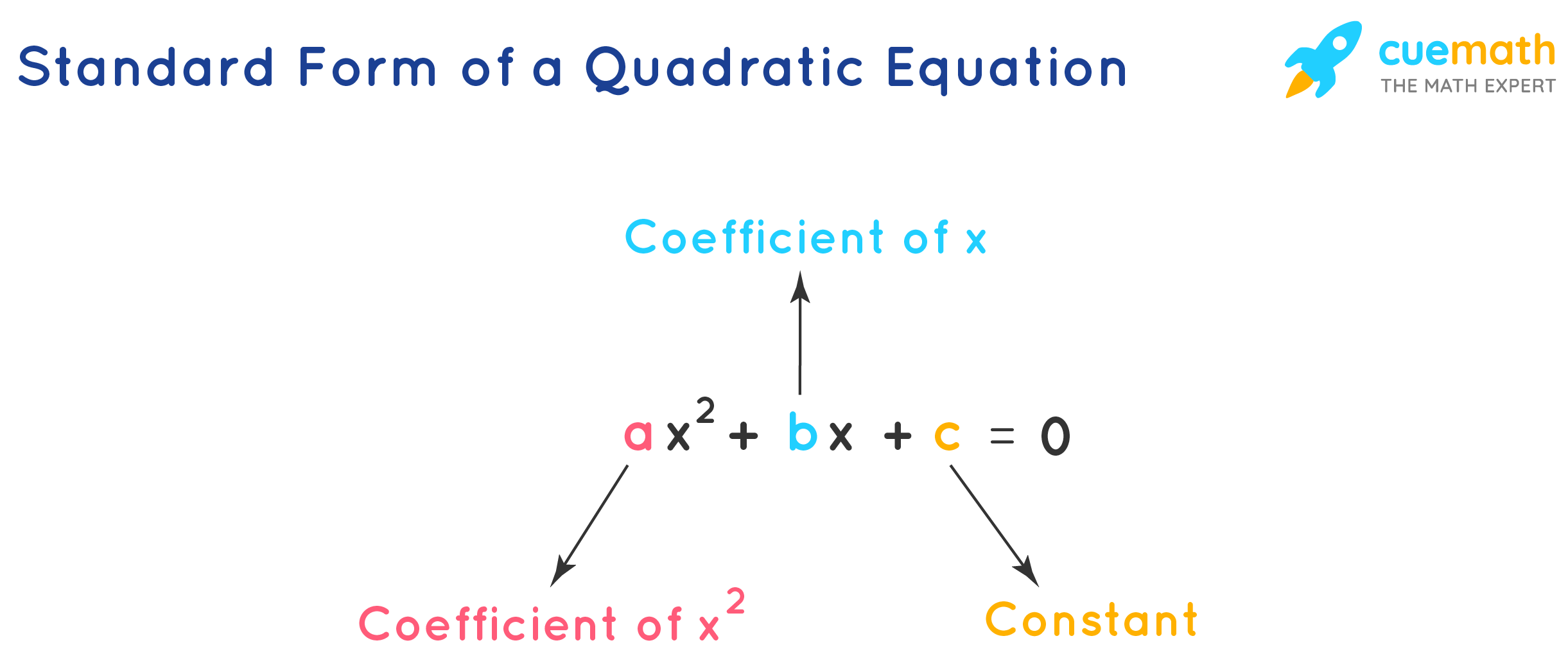
Further in real math problems the quadratic equations are presented in different forms: (x - 1)(x + 2) = 0, -x2 = -3x + 1, 5x(x + 3) = 12x, x3 = x(x2 + x - 3). All of these equations need to be transformed into standard form of the quadratic equation before performing further operations.
Quadratic Equation Formula
Quadratic Formula is the simplest way to find the roots of a quadratic equation. There are certain quadratic equations that cannot be easily factorized, and here we can conveniently use this quadratic formula to find the roots in the quickest possible way. The roots of the quadratic equation further help to find the sum of the roots and the product of the roots of the quadratic equation. The two roots in the quadratic formula are presented as a single expression. The positive sign and the negative sign can be alternatively used to obtain the two distinct roots of the equation.
Quadratic Formula = [-b ± √(b² - 4ac)]/2a
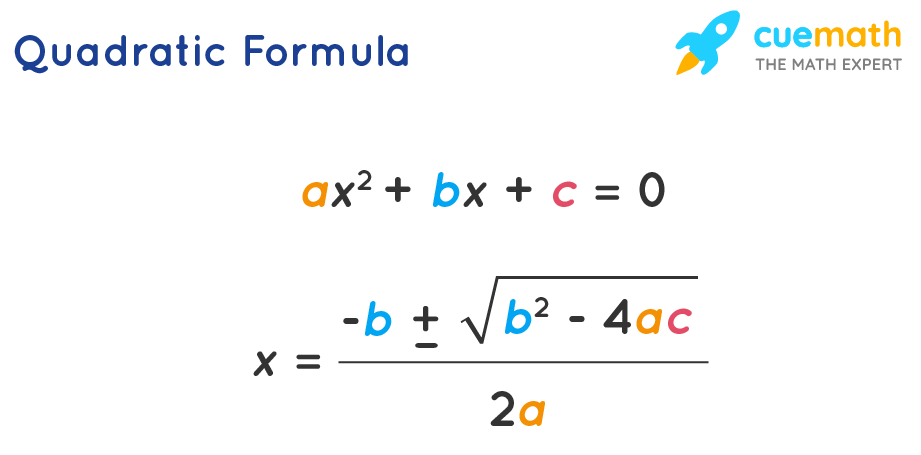
Important Formulas for Solving Quadratic Equations
The following list of important formulas is helpful to solve quadratic equations.
- The quadratic equation in its standard form is ax2 + bx + c = 0
- The discriminant of the quadratic equation is D = b2 - 4ac
- For D > 0 the roots are real and distinct.
- For D = 0 the roots are real and equal.
- For D < 0 the roots do not exist, or the roots are imaginary.
- The formula to find the roots of the quadratic equation is x = \( \frac{-b \pm\sqrt{b^2 - 4ac}}{2a}\).
- The sum of the roots of a quadratic equation is α + β = -b/a = - Coefficient of x/ Coefficient of x2.
- The product of the Root of the quadratic equation is αβ = c/a = Constant term/ Coefficient of x2
- The quadratic equation having roots α, β, is x2 - (α + β)x + αβ = 0.
- The condition for the quadratic equations \(a_1x^2 + b_1x + c_1 = 0\), and \(a_2x^2 + b_2x + c_2 = 0\) having the same roots is \(\dfrac{(a_1b_2 - a_2b_1)}{(b_1c_2 - b_2c_1)}\) = \((a_2c_1 - a_1c_2)^2\).
- For positive values of a (a > 0), the quadratic expression f(x) = ax2 + bx + c has a minimum value at x = -b/2a.
- For negative value of a (a < 0), the quadratic expression f(x) = ax2 + bx + c has a maximum value at x = -b/2a.
- For a > 0, the range of the quadratic equation ax2 + bx + c = 0 is [b2 - 4ac/4a, ∞)
- For a < 0, the range of the quadratic equation ax2 + bx + c = 0 is : (∞, -(b2 - 4ac)/4a]
Quadratic Formula Proof
Consider an arbitrary quadratic equation: ax2 + bx + c = 0, a ≠ 0
To determine the roots of this equation, we proceed as follows:
ax2 + bx = -c ⇒ x2 + bx/a = -c/a
Now, we express the left hand side as a perfect square, by introducing a new term (b/2a)2 on both sides:
x2+ bx/a + (b/2a)2 = -c/a + (b/2a)2
The left hand side is now a perfect square:
(x + b/2a)2 = -c/a + b2/4a2 ⇒ (x + b/2a)2 = (b2 - 4ac)/4a2
This is good for us, because now we can take square roots to obtain:
x + b/2a = ±√(b2 - 4ac)/2a
x = (-b ± √(b2 - 4ac))/2a
Thus, by completing the squares, we were able to isolate x and obtain the two roots of the equation.
Roots of a Quadratic Equation
The roots of a quadratic equation are the two values of x, which are obtained by solving the quadratic equation. The roots of a quadratic equation are referred to by the symbols alpha (α), and beta (β). These roots of the quadratic equation are also called the zeros of the equation. Here we shall learn more about how to find the nature of roots of a quadratic equation without actually finding the roots of the equation. And also check out the formulas to find the sum and the product of the roots of the equation.
Nature of Roots of the Quadratic Equation
The nature of roots of a quadratic equation can be found without actually finding the roots (α, β) of the equation. This is possible by taking the discriminant value, which is part of the formula to solve the quadratic equation. The value b2 - 4ac is called the discriminant of a quadratic equation, and is designated as 'D'. Based on the discriminant value the nature of the roots of the quadratic equation can be predicted.
Discriminant: D = b2 - 4ac
- D > 0, the roots are real and distinct
- D = 0, the roots are real and equal.
- D < 0, the roots do not exist or the roots are imaginary.
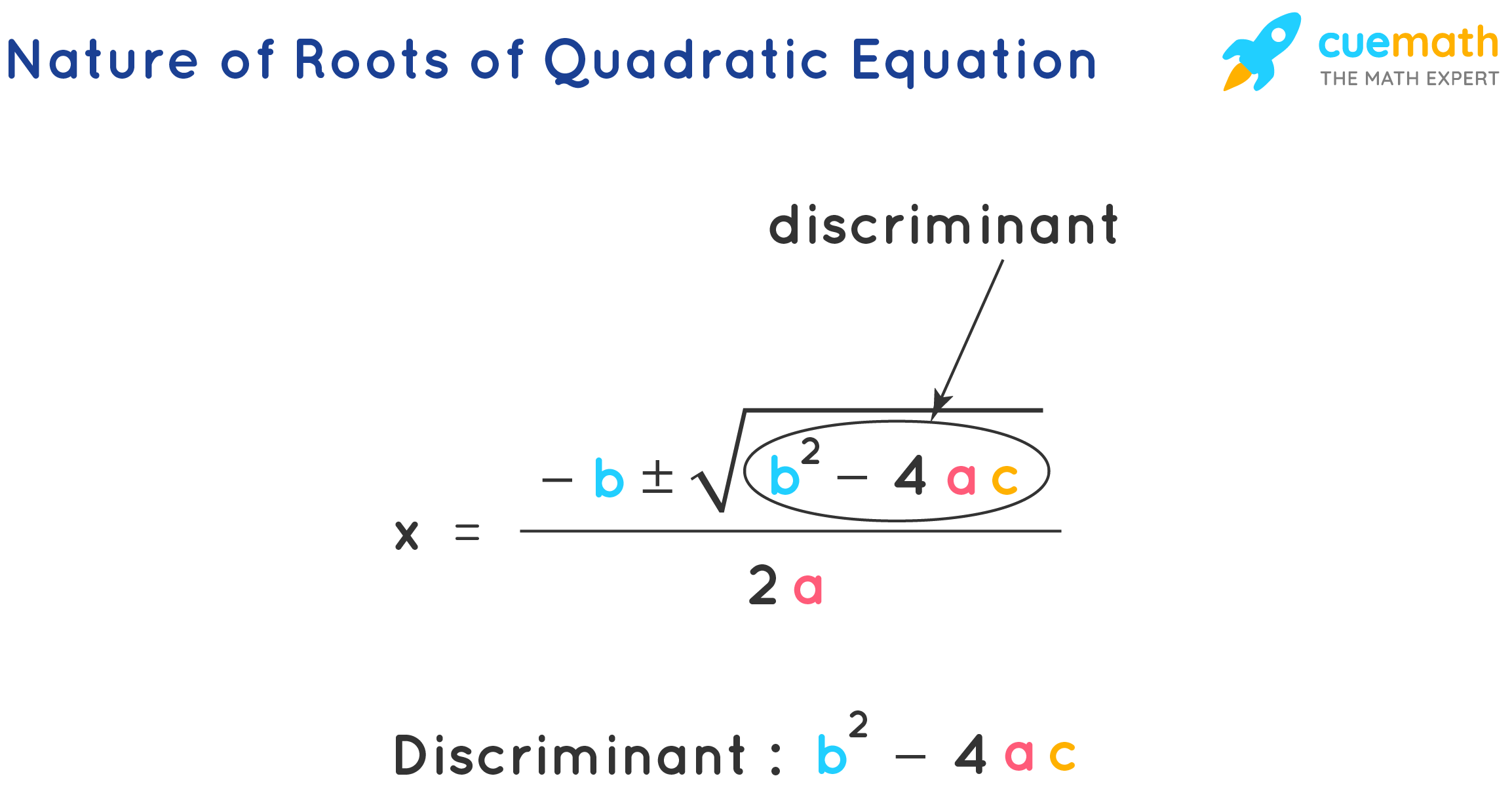
Relationship Between Coefficients and Roots of Quadratic Equation
The coefficient of x2, x term, and the constant term of the quadratic equation ax2 + bx + c = 0 are useful to study more about the properties of roots of the quadratic equation. The sum and product of roots of a quadratic equation can be directly calculated from the equation, without actually finding the roots of the quadratic equation. The sum of the roots of the quadratic equation is equal to the negative of the coefficient of x divided by the coefficient of x2. The product of the root of the equation is equal to the constant term divided by the coefficient of the x2. For a quadratic equation ax2 + bx + c = 0, the sum and product of the roots are as follows.
- Sum of the Roots: α + β = -b/a = - Coefficient of x/ Coefficient of x2
- Product of the Roots: αβ = c/a = Constant term/ Coefficient of x2
The quadratic equation can also be formed for the given roots of the equation. If α, β, are the roots of the quadratic equation, then the quadratic equation is as follows.
x2 - (α + β)x + αβ = 0
Methods to Solve Quadratic Equations
A quadratic equation can be solved to obtain two values of x or the two roots of the equation. There are four different methods to find the roots of the quadratic equation. The four methods of solving the quadratic equations are as follows.
- Factorizing of Quadratic Equation
- Formula Method of Finding Roots
- Method of Completing the Square
- Graphing Method to Find the Roots
Let us look in detail at each of the above methods to understand how to use these methods, their applications, and their uses.
Factorization of Quadratic Equation
Factorization of quadratic equation follows a sequence of steps. For a general form of the quadratic equation ax2 + bx + c = 0, we need to first split the middle term into two terms, such that the product of the terms is equal to the constant term. Further, we can take the common terms from the available term, to finally obtain the required factors. For understanding factorization, the general form of the quadratic equation can be presented as follows.
- x2 + (a + b)x + ab = 0
- x2 + ax + bx + ab = 0
- x(x + a) + b(x + a)
- (x + a)(x + b) = 0
Let us understand factorization through the below example.
- x2 + 5x + 6 = 0
- x2 + 2x + 3x + 6 = 0
- x(x + 2) + 3(x + 2) = 0
- (x + 2)(x + 3) = 0
Thus the two obtained factors of the quadratic equation are (x + 2) and (x + 3).
Quadratic Formula to Find Roots
The quadratic equations which cannot be solved through the method of factorization can be solved with the help of a formula. The formula to solve the quadratic equation uses the terms from the standard form of a quadratic equation. Through the below formula we can obtain the two roots of x by first using the positive sign in the formula and then using the negative sign. Any quadratic equation can be solved using this formula.

Further to the above-mentioned two methods of solving quadratic equations, there is another important method of solving a quadratic equation. The method of completing the square for a quadratic equation is also useful to find the roots of the equation. This method includes numerous algebraic calculations and hence has been explained as a separate topic.
Method of Completing the Square
The method of completing the square for a quadratic equation, is to algebraically square and simplify, to obtain the required roots of the equation. Consider a quadratic equation ax2 + bx + c = 0, a ≠ 0. To determine the roots of this equation, we simplify it as follows:
- ax2 + bx + c = 0
- ax2 + bx = -c
- x2 + bx/a = -c/a
Now, we express the left hand side as a perfect square, by introducing a new term (b/2a)2 on both sides:
- x2 + bx/a + (b/2a)2 = -c/a + (b/2a)2
- (x + b/2a)2 = -c/a + b2/4a2
- (x + b/2a)2 = (b2 - 4ac)/4a2
- x + b/2a = +√(b2- 4ac)/2a
Now with this method of completing the square, we could consolidate the value for the roots of the equation. Further on simplification and taking the square root, the two possible roots of the quadratic equation are, x = (-b + √(b2- 4ac))/2a. Here the '+' sign gives one root and the '-' sign gives another root of the quadratic equation. Generally, this detailed method is avoided, and only the formula is used to obtain the required roots.
Graphing a Quadratic Equation
The graph of the quadratic equation ax2 + bx + c = 0 can be obtained by representing the quadratic equation as a function y = ax2 + bx + c. Further on solving and substituting values for x, we can obtain values of y, we can obtain numerous points. These points can be presented in the coordinate axis to obtain a parabola-shaped graph for the quadratic equation.
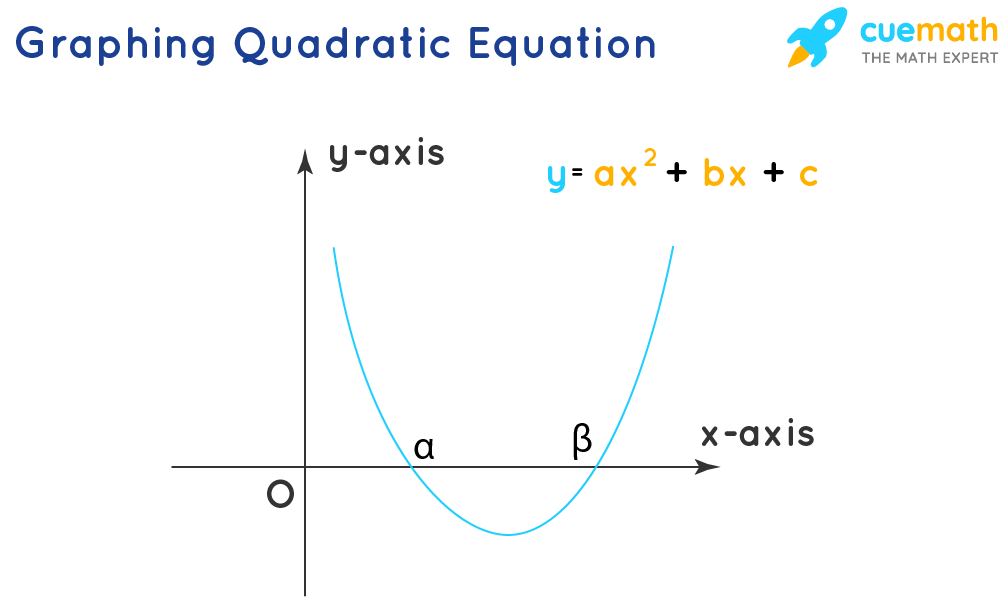
The point where the graph cuts the horizontal x-axis is the solution of the quadratic equation. These points can also be algebraically obtained by equalizing the y value to 0 in the function y = ax2 + bx + c and solving for x.
Quadratic Equations Having Common Roots
The two quadratic equation having common roots are \(a_1x^2 + b_1x + c_1 = 0\), and \(a_2x^2 + b_2x + c_2 = 0\). Let us solve these two equations to find the conditions for which these equations have a common root. The two equations are solved for x2 and x respectively.
\(\dfrac{x^2}{(b_1c_2 - b_2c_1)}\) = \(\dfrac{-x}{(a_1c_2 - a_2c_1)}\) = \(\dfrac{1}{(a_1b_2 - a_2b_1)}\)
\(x^2 =\dfrac{(b_1c_2 - b_2c_1)}{(a_1b_2 - a_2b_1)}\)
\(x=\dfrac{(a_2c_1 - a_1c_2)}{(a_1b_2 - a_2b_1)}\)
Hence of simplifying the above two expressions we have the following condition for the the two equations having the common root.
\(\dfrac{(a_1b_2 - a_2b_1)}{(b_1c_2 - b_2c_1)}\) = \((a_2c_1 - a_1c_2)^2\)
Maximum and Minimum Value of Quadratic Expression
The maximum and minimum value for the quadratic equation ax2 + bx + c = 0 can be observed in the below graphs. For positive values of a (a > 0), the quadratic expression has a minimum value at x = -b/2a, and for negative value of a (a < 0), the quadratic expression has a maximum value at x = -b/2a.
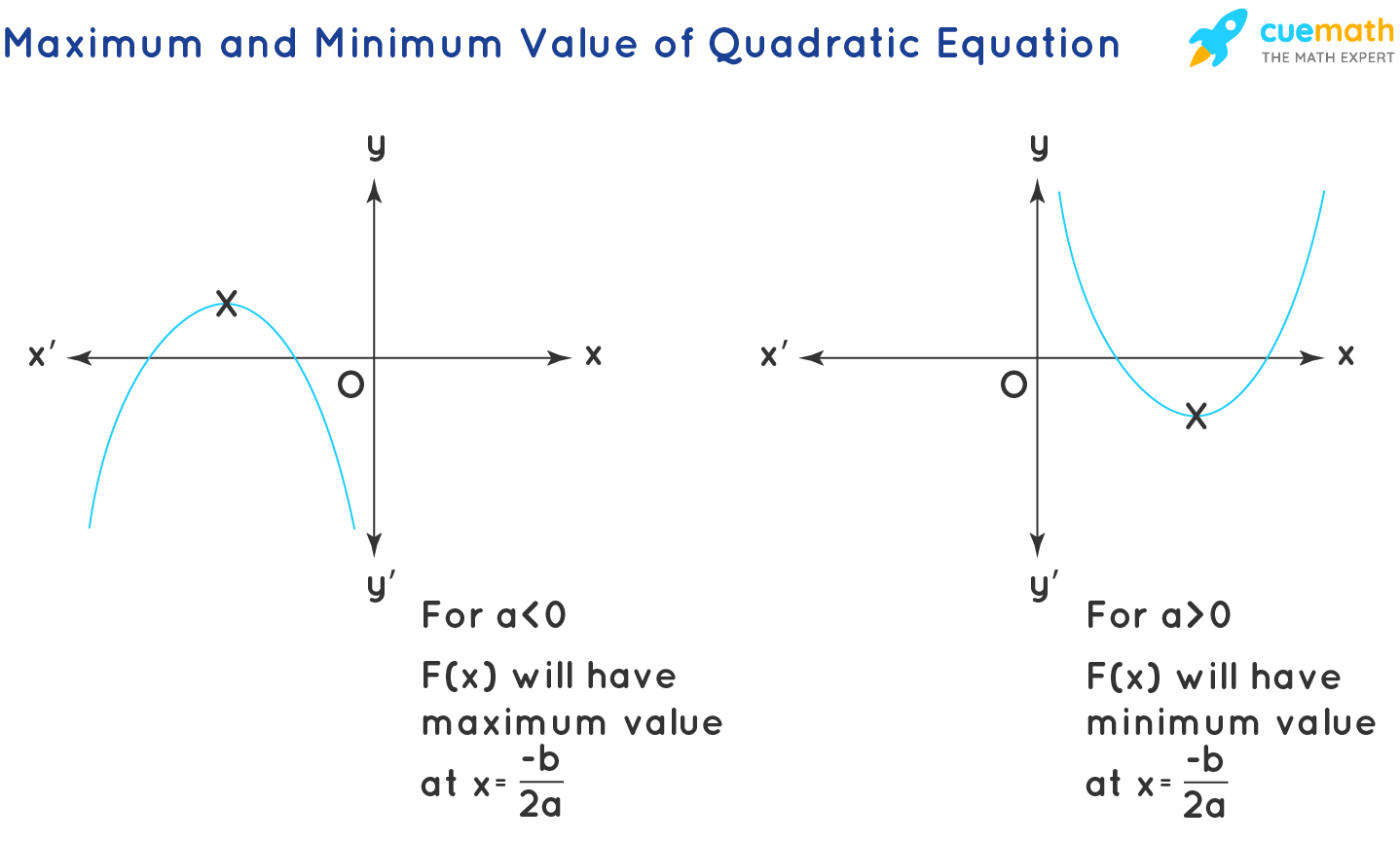
The maximum and minimum values of the quadratic expressions are of further help to find the range of the quadratic expression: The range of the quadratic expressions also depends on the value of a. For positive values of a( a > 0), the range is [ f(-b/2a), ∞), and for negative values of a ( a < 0), the range is (-∞, f(-b/2a)].
- For a > 0, Range: [ f(-b/2a), ∞)
- For a < 0, Range: (-∞, f(-b/2a)]
Solving a Quadratic Equation - Tips and Tricks
Some of the below-given tips and tricks on quadratic equations are helpful to more easily solve quadratic equations.
- The quadratic equations are generally solved through factorization. But in instances when it cannot be solved by factorization, the formula is used.
- The roots of a quadratic equation are also called the zeroes of the equation.
- For quadratic equations having negative discriminant values, the roots are represented with the help of complex numbers.
- The sum and product of roots of a quadratic equation can be used to find higher algebraic expressions involving these roots.
Related Topics
- Zeroes and Roots
- Nature of Roots - Examples
- Square Root
- Roots Calculator
- Factorization of Quadratic Equations
- Sum and Product of Roots
- Conditions on Roots of Quadratics
- Roots of Quadratic Equation Calculator
Examples on Quadratic Equations
-
Example 1: Meghan is a fitness enthusiast and goes for a jog every morning. The park where she jogs is rectangular in shape and measures 12m × 8m. An environmentalist group plans to revamp the park and decides to build a pathway surrounding the park. This would increase the total area to 140 sq m. What will be the width of the pathway?
Solution:
Let's denote the width of the pathway by x.
Then, the length and breadth of the outer rectangle is (12+2x) m and (8+2x) m.
According to the question,
(12 + 2x)(8 + 2x) = 140
2(6 + x) 2(4 + x) = 140
(6 + x)(4 + x) = 35
24 + 6x + 4x + x2 = 35
x2 + 10x -11 = 0
x2 + 11x - x - 11 = 0
x(x + 11) - 1(x + 11) = 0
(x + 11)(x - 1) = 0
(x + 11) =0 and (x - 1) = 0
x = -11 and x = 1
Since length can't be negative, we take x = 1.
Answer: Therefore the width of the pathway is 1m.
-
Example 2: Let's learn how a quadratic equation question finds its application in the field of motion. Rita throws a ball upwards from a platform that is 20m above the ground. The height of the ball from the ground at a time 't', is denoted by 'h'. Suppose h = -4t2 + 16t + 20. Find the maximum height attained by the ball.
Solution:
We can rearrange the terms of the quadratic equation
h = -4t2 + 16t + 20
in such a way that it is easy to find the maximum value of this equation.
h = -4t2 + 16t + 20
= -4t2 + 16t + 20
= -4(t2 - 4t - 5)
= -4((t - 2)2 - 9)
= -4(t - 2)2 + 144
We should keep the value of (t-2)2 minimum in order to find the maximum value of h.
So, the minimum value (t-2)2 can take is 0.
Answer: Therefore the maximum height attained is 144m.
-
Example 3: Find the quadratic equation having the roots 5 and 8 respectively.
Solution:
The quadratic equation having the roots α, β, is x2 - (α + β)x + αβ = 0.
Given α = 5, and β = 8.
Therefore the quadratic equation is:
x2 - (5 + 8)x + 5×8 = 0
x2 - 13x + 40 = 0
Answer: Hence the required quaratic equation is x2 - 13x + 40 = 0
-
Example 4: The quadratic equation 2x2 + 9x + 7 = 0 has roots α, β. Find the quadratic equation having the roots 1/α, and 1/β.
Solution:
The quadratic equation having roots that are reciprocal to the roots of the equation ax2 + bx + c = 0, is cx2 + bx + a = 0.
The given quadratic equation is 2x2 + 9x + 7 = 0.
Hence the required equation having reciprocal roots is 7x2 + 9x + 2 = 0.
Answer: Therefore the equation is 7x2 + 9x + 2 = 0.
go to slidego to slidego to slidego to slide

Breakdown tough concepts through simple visuals.
Math will no longer be a tough subject, especially when you understand the concepts through visualizations.
Book a Free Trial Class
Practice Questions on Quadratic Equations
go to slidego to slide
FAQs on Quadratic Equation
What is a Quadratic Equation?
A quadratic equation in math is a second-degree equation of the form ax² + bx + c = 0. Here a, b, are the coefficients, c is the constant term, and x is the variable. Since the variable x is of the second degree, there are two roots or answer for this quadratic equation. The roots of the quadratic equation can be found by either solving by factorizing or through the use of a formula.
What is the Quadratic Formula?
The quadratic formula to solve a quadratic equation ax² + bx + c = 0 is x = [-b ± √(b² - 4ac)]/2a. Here we obtain the two values of x, by applying the plus and minus symbol in this formula. Hence the two possible values of x are [-b + √(b² - 4ac)]/2a, and [-b - √(b² - 4ac)]/2a.
How to Apply Quadratic Formula?
The values of a, b, and c are applied to the quadratic formula x = [-b ± √(b² - 4ac)]/2a, to obtain the two roots of the quadratic equation.
What is Determinant in Quadratic Formula?
The value b² - 4ac is called the determinant and is designated as D. The determinant is part of the quadratic formula. The determinants help us to find the nature of the roots of the quadratic equation, without actually finding the roots of the quadratic equation.
What are Some Real Life Applications of Quadratic Equations
Quadratic equations are used to find the zeroes of the parabola and its axis of symmetry. There are many real-world applications of quadratic equations. For instance, it can be used in running time problems to evaluate the speed, distance or time while traveling by car, train or plane. Quadratic equations describe the relationship between quantity and the price of a commodity. Similarly, demand and cost calculations are also considered quadratic equation problems. It can also be noted that a satellite dish or a reflecting telescope has a shape that is defined by a quadratic equation.
How are Quadratic Equations Different From Linear Equations?
A linear degree is an equation of a single degree and one variable, and a quadratic equation is an equation in two degrees and a single variable. A linear equation is of the the form ax + b = 0 and a quadratic equation is of the form ax² + bx + c = 0. A linear equation has a single root and a quadratic equation has two roots or two answers. Also, a quadratic equation is a product of two linear equations.
How to Simplify a Quadratic Equation?
The first step in the process of simplifying a quadratic equation is to transform it into the standard form ax² + bx + c = 0. Further, it can be simplified by finding its factors through the process of factorization. Also for an equation for which it is difficult to factorize, it is solved by using the formula. Additionally, there are a few other ways of simplifying a quadratic equation.
What Are the 4 Ways To Solve A Quadratic Equation?
The four ways of solving a quadratic equation are as follows.
- Factorizing method
- Formula Method
- Method of Completing Squares
- Graphing Method
How Do you Solve a Quadratic Equation By Factoring?
The quadratic equation can be solved by factorization through a sequence of three steps. First split the middle term, such that the product of the split terms is equal to the product of the first and the last terms. Let us assume the quadratic equation is of the form x² + (a + b)x + ab = 0, and it can be split as x² + ax + bx + ab = 0. As a second step, take the common term from the first two and the last two terms. x(x + a) + b(x + a) = 0, (x + a)(x + b) = 0. Finally equalize each of the factors to zero and obtain the x values. x + a = 0 and x + b = 0, and hence we can obtain x = -a and x = -b
How to Solve a Quadratic Equation by Completing the Square?
The quadratic equation solved by the method of completing the square and it uses the formula (a + b)² = a²
How to Find the Value of the Discriminant?
The value of the discriminant in a quadratic equation can be found from the variables and constant terms of the standard form of the quadratic equation ax² + bx + c = 0. The value of the discriminant is D = b² - 4ac, and it helps to predict the nature of roots of the quadratic equation, without actually finding the roots of the equation.
How Do You Solve Quadratic Equations With Graphing?
The quadratic equation can be solved similarly to a linear equal by graphing. Let us take the quadratic equation ax² + bx + c = 0 as y = ax² + bx + c . Here we take the set of values of x and y and plot the graph. These two points where this graph meets the x-axis, are the possible solutions of this quadratic equation.
How To Find Nature of Roots of Quadratic Equation?
The discriminant is helpful to predict the nature of the roots of the quadratic equation. The determinant of a quadratic equation ax² + bx + c = 0 is b² - 4ac. The discriminant is referred as D = b² - 4ac. If D > 0 the roots are real and distinct, for D = 0 the roots are equal, and for D < 0 the roots are imaginary complex numbers.
How Important Is the Discriminant in Determining the Nature of Roots of Quadratic Equation?
The discriminant is very much needed to easily find the nature of roots of the quadratic equation. Without the discriminant, finding the nature of the roots of the equation is a long process, as we first need to solve the equation to find both the roots. Hence the discriminant is an important and the needed quantity, which helps to easily find the nature of roots of the quadratic equation.
When Do Quadratic Equations Have Equal Roots?
The given quadratic equation has equal roots if the discriminant is equal to zero. For a quadratic equation of the form ax² + bx + c = 0 the discriminant is D = b² - 4ac = 0. Here both are roots are equal and each has a value of x = -b/2a.
What is the Use of Determinants in Quadratic Formula?
The determinant (D = b² - 4ac) is useful to predict the nature of the roots of the quadratic equation. For D > 0, the roots are real and distinct, for D = 0 the roots are real and equal, and for D < 0, the roots do not exist or the roots are imaginary complex numbers. With the help of this determinant and with the least calculations, we can find the nature of the roots of the quadratic equation.
How Many Roots does Quadratic Equation Have?
It is a second-degree equation in x, and hence two roots are obtained. We can obtain these roots of a quadratic equation using the quadratic formula. One root can be obtained using the positive sign and we can get another root by applying the negative sign in the formula.
How do you Solve a Quadratic Equation without Using the Quadratic Formula?
There are two alternative methods to the quadratic formula. One method is to solve the quadratic equation through factorization, and another method is by completing the squares. In total there are three methods to find the roots of a quadratic equation.
How is Quadratic Formula used to Solve a Quadratic Equation?
The algebra formula (a + b)² = a² + 2ab + b² is used to solve the quadratic equation and derive the quadratic formula. This algebraic formula is used to manipulate the quadratic equation and derive the quadratic formula to find the roots of the equation.
How to Find the Solution of Quadratic Equation
Source: https://www.cuemath.com/algebra/quadratic-equations/